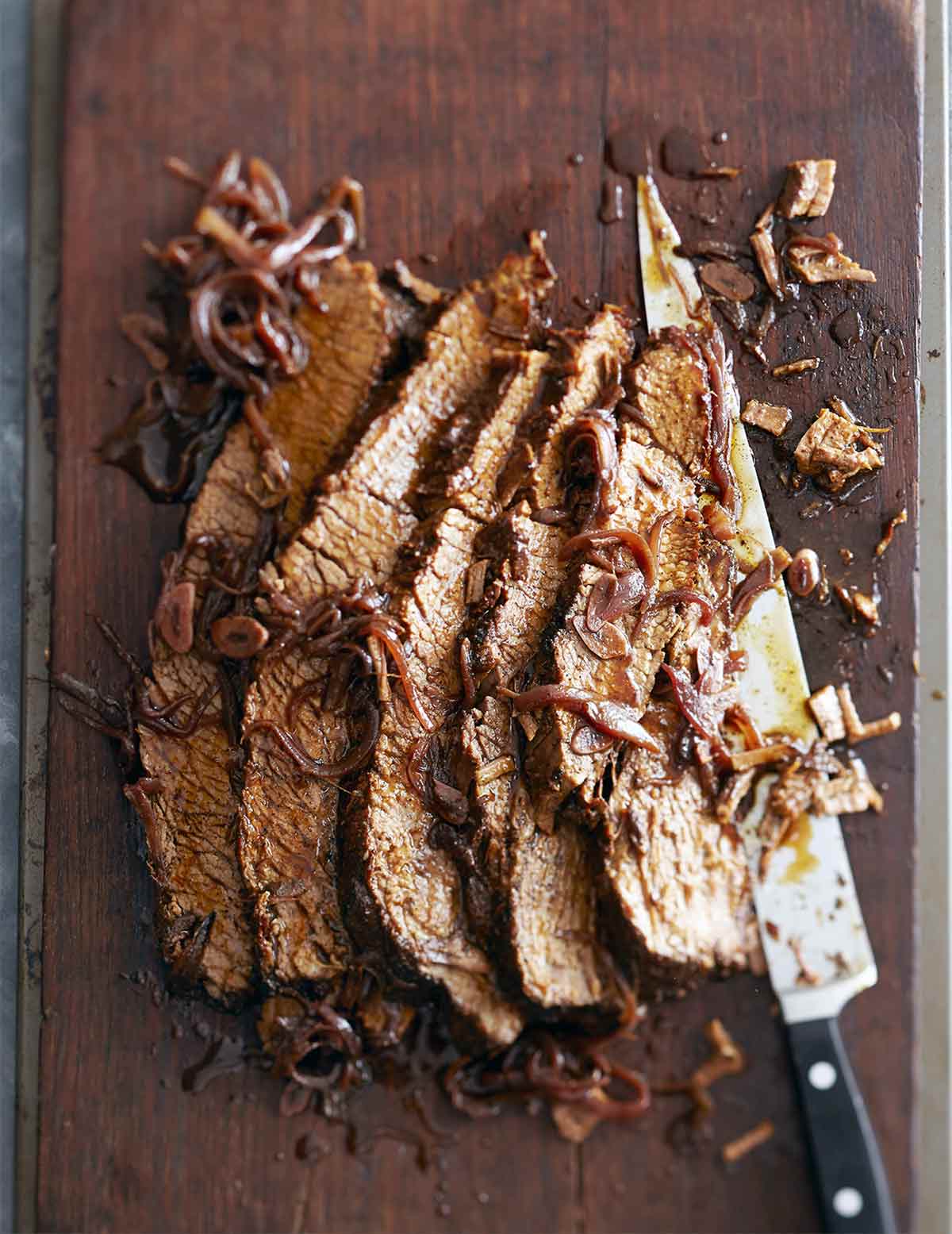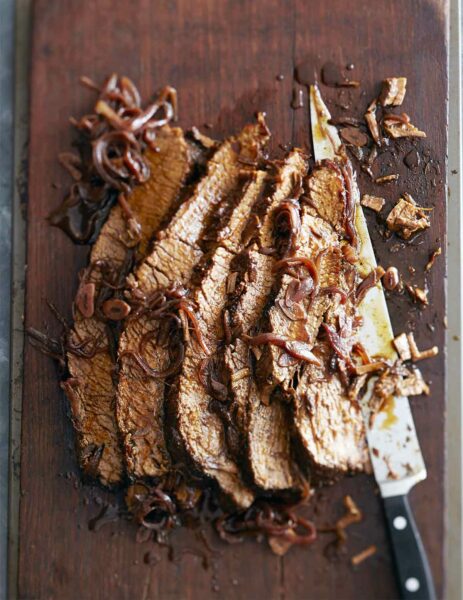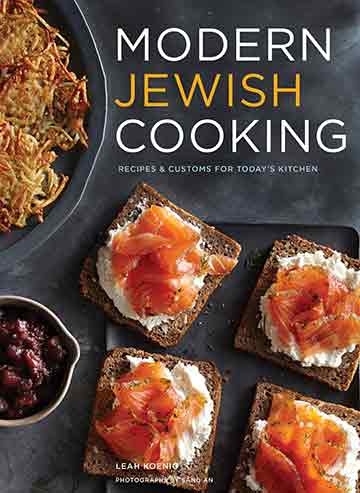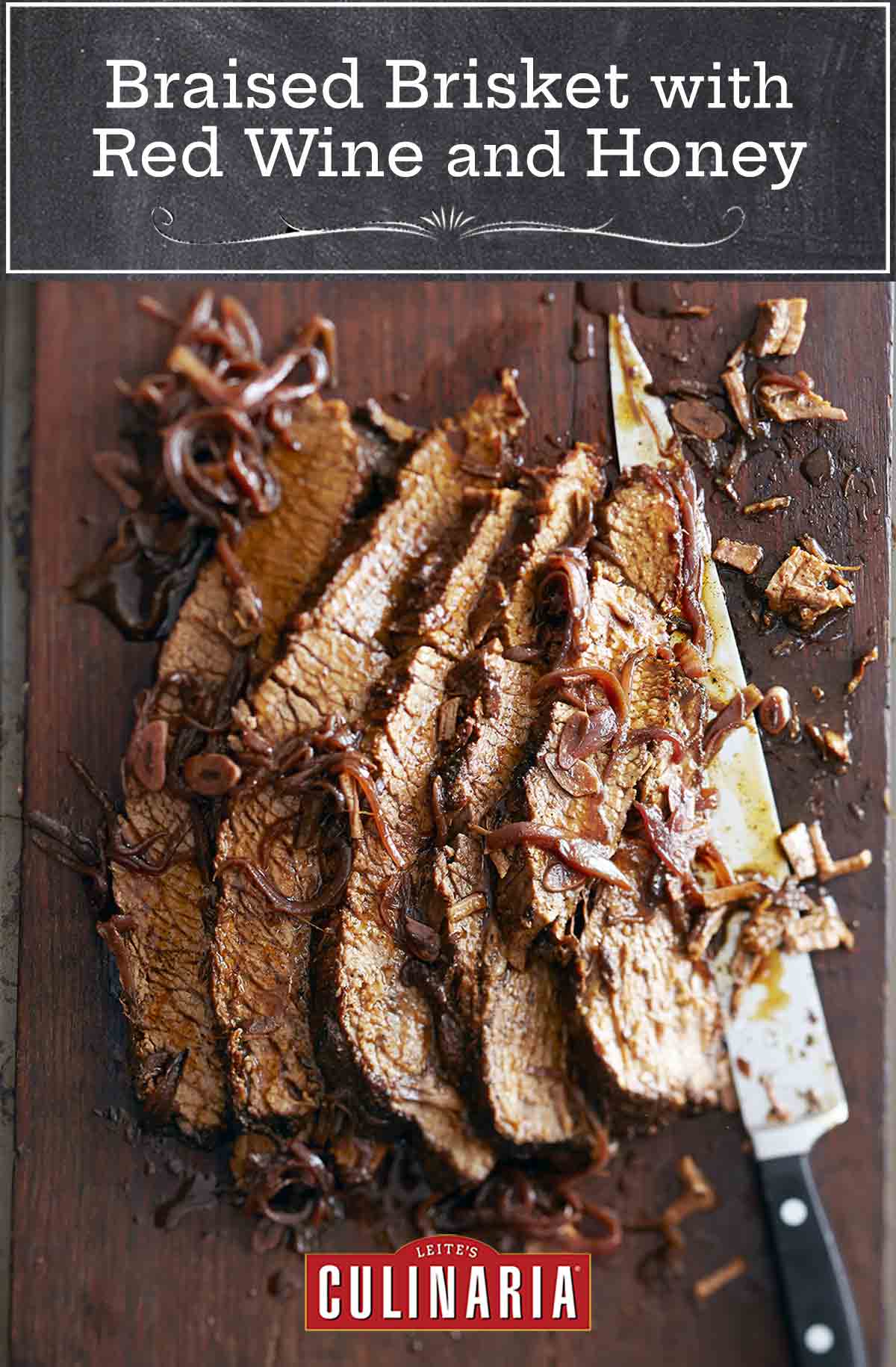
Braised beef brisket is the Proustian madeleine of Jewish cooking. Or so says cookbook author Leah Koenig.
While there’s no question that the braised brisket your bubbe made was the best brisket ever, this slightly inebriated braised brisket with red wine and honey is about to become your very close second favorite brisket ever. It’s slowly suffused with red wine and honey until it’s sweet and tangy and meltingly tender through and through. (Did you just go weak in the knees? We did.)–David Leite
Brisket FAQs
This recipe calls for second-cut brisket, which is sometimes referred to as deckle. Second-cut brisket is fattier and richer than first-cut brisket, with a taste and texture that’s actually more akin to that of short ribs. It can be tricky to find in grocery stores (except in Texas), so you may need to special order it from your butcher.
If all you can find is first-cut brisket, which is typically labeled simply “brisket,” go ahead and use it. The recipe will still turn out delicious…just ever so slightly less special than if you’d made it with second-cut. But if you don’t say anything, none of your guests will be the wiser.
Use a sharp knife so that you are slicing the onion rather than crushing it. Also, try chilling your onions in the fridge or a bowl of ice water for 30 minutes before slicing them.
A bowl of mashed potatoes to sop up those juices would be wonderful, and any roasted vegetable, such as roasted fennel, roasted parsnips, or squash strata would round out the meal nicely.

Braised Brisket with Red Wine and Honey
Ingredients
- 4 to 5 pounds brisket, preferably second-cut
- Kosher salt and freshly ground pepper
- 1 tablespoons mild olive or vegetable oil
- 3 large yellow onions, halved through the roots and thinly sliced
- 8 sprigs fresh thyme
- 8 garlic cloves, thinly sliced
- 2 bay leaves
- 1 1/2 cups dry red wine
- 3 tablespoons balsamic vinegar
- 1/4 cup honey
- 1 teaspoon onion powder
- 1 teaspoon garlic powder
- 1 cup homemade chicken stock or canned chicken broth
Instructions
- Preheat the oven to 325°F (160°C). Generously season both sides of the brisket with salt and pepper.
- Heat the oil in a Dutch oven or large pot set over medium-high heat. Add the brisket and cook, turning once, until browned on both sides, 8 to 10 minutes total. (If the brisket does not fit all at once, cut it in half and sear it in batches.)
- Remove the brisket from the pot and set aside on a cutting board. Add the onions, thyme, garlic, and bay leaves to the pot, then pour in 1/2 cup (120 milliliters) of the wine and the vinegar. Cook, stirring often, until the onions soften slightly and the mixture is fragrant, about 5 minutes.
- Whisk together the remaining 1 cup (240 ml) wine, honey, onion powder, garlic powder, stock, and 1 teaspoon salt in a medium bowl until fully combined. If you used a Dutch oven, lay the brisket on top of the onions and pour the wine mixture over the top. Cover and move to the oven. If you used a pot, dump the onion mixture into a roasting pan and top with the brisket. Pour the wine mixture over the top. Cover tightly with aluminum foil and transfer to the oven.
- Cook the brisket for 2 hours. Remove from the oven, uncover, and carefully flip the meat. Cover and continue to roast until the meat is fork-tender, 1 1/2 to 2 1/2 hours more, depending on the size of your brisket.
- Remove from the oven and place the brisket on a cutting board. Cover loosely with foil and let rest for 10 to 15 minutes before slicing. Locate the thin lines running in one direction along the brisket and use a sharp knife to cut thin slices perpendicular to those lines.
- Meanwhile, remove and discard the thyme sprigs and bay leaves from the cooking liquid. Use a slotted spoon to remove the onions and arrange them around the sliced brisket. Spoon the desired amount of pan juices over the brisket. Serve hot.

Explore More with AI
Nutrition
Nutrition information is automatically calculated, so should only be used as an approximation.
Recipe Testers’ Reviews
If this braised brisket recipe had a tagline, it would be “A brisket worth the tears.” Yes, your eyes will get very watery thinly slicing all those onions, but boy, is this delicious roast worth it. It’s beefy, robust, and full of lovely savory flavors.
All that is very well balanced with the deep flavor of the caramelized onions and the sweet and savory of red wine and honey. It’s a special occasion roast but is very simple to make. Another benefit is that the kitchen smells heavenly as the brisket slowly bakes.
I live in Texas, so I had no problem buying a prime grade full brisket. I trimmed it and cut off the deckle to use. I froze the rest.
The brisket chunk did fit in my oval-shaped Le Creuset Dutch oven, but a bit too snugly, so I didn’t sear it in there. I also didn’t want to cut the brisket in half, so I ended up searing it in a large heavy skillet that was big enough
I transferred the brisket to the Dutch oven and deglazed the skillet with some of the stock so as not to lose the browned stuck bits and added that to the Dutch oven. I took it out 2 hours after flipping it (total cooking time of 4 hours), and it was maybe a touch too tender. I would start checking on it 1 hour after flipping it to see if it’s done.
I highly recommend cooking the brisket a day before serving and refrigerating it. That was what I did, and it was easier to remove the layer of fat, and the brisket tasted and sliced so much better.
The aroma enveloping my entire house while this red wine and honey brisket was in the oven was intoxicating. And the caramelized onions with wine reduction were just gilding the lily. I made truffle mashed potatoes to complement the brisket.
Adding cut Idaho potatoes and root vegetables to the braised brisket would render a simple yet satisfying meal. I can only imagine how ridiculously tasty the potatoes would be after caramelizing and basking in the juices.
The bottom of the brisket that was sitting on the onion mixture remained moist, but the top hardened and became chewy. Overall, the brisket did fall apart, but after 4 hours of cooking, there were no juices left to baste the brisket with before serving. Perhaps adding 1 cup more of stock would eliminate the issue?
When I have the time to slowly cook a nice piece of meat like a brisket, pot roast, veal shank, you name it, I jump on the opportunity. The low heat and length of time that these cuts cook for ensure a fork-tender, fall-apart piece of meat that also creates its own decadent sauce. This braised beef brisket recipe was no exception.
In terms of the recipe itself, I couldn’t find a second-cut brisket, but the recipe worked wonderfully with first-cut. I had some homemade chicken stock in the fridge, so that’s what I used. I browned the brisket for 5 minutes on each side, which ensured a nice sear on the meat.
I cooked my brisket in a Dutch oven, so I placed the brisket on top of the onions and poured the wine mixture over the meat before covering and roasting it. I roasted the meat for 2 hours to start, turned it over, and cooked it for 2 more hours. It was perfectly cooked by then. In fact, I barely had to cut the brisket after 4 hours of cooking—when I touched it with a knife, it just fell apart. Now that’s what I call a perfectly cooked brisket!
The flavor of the honey, balsamic, and red wine was divine and made for a lovely sauce coating the meat and onions. What a perfect Sunday dinner this braised brisket with red wine and honey was. Mashed potatoes and your favorite green vegetable would be great sides for this dish. Yum!
This recipe is pretty much a basic braised brisket. The flavors are rich, deep, and complex. I wasn’t sure I’d have the time to prep and cook the recipe all in one day, so I seared the brisket and sautéed the onions a day in advance.
I left my Dutch oven in the refrigerator overnight and then brought the meat and onions to room temperature, poured the wine mixture on top, and transferred the pot to the oven. I knew I had a taster who wouldn’t want the onions, so I strained the pan juices and served the onions and the juices separately. The juices were a nice consistency, so I didn’t feel it was necessary to reduce them.














Wow! I’m used to Texas smoked brisket so was a little tentative trying this. It was absolutely wonderful! Tender and very flavorful. Taking it over the top was putting those onions from the pan on the meat before eating it! I will definitely be making this again, although probably a winter dish for us because summer means smoking those briskets outside! Great recipe!
Rhonda, I love that you stepped out of your Texas smoked brisket comfort zone to try this. I’m thrilled it was a hit—and yes, those onions are absolute magic, aren’t they? They’re the unsung heroes of this dish.
I totally get keeping it as a cozy winter favorite and saving the smoker for summer, but it’s great to know this recipe has earned a spot in your brisket rotation. Thanks so much for sharing your experience, and I can’t wait to hear when you make it again!
This has become my go-to brisket recipe for years now. I was looking for something that didn’t use bottled sauces or soup mixes. This recipe delivered! And it’s, dare I say, better than those other briskets! I usually marinate the beef in the red wine overnight before making the recipe. It gives the beef a deep flavor. it’s always eaten up and I’m always getting compliments!
Shevi, I love to hear this! I’m so delighted you enjoy this so much.